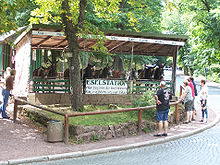Donkey station
The donkey station , also referred to as “the donkey egg ” in old Eisenach city guides, is the traditional stand of the Wartburg donkey and in the spring and summer months it is a tourist attraction on the main access route to the Wartburg . Since 1900 tourists, usually children, have been able to ride the eight to ten donkeys up a 400 m long stretch to the castle. The Elisabeth Fountain is very close by .
history
The ancestors of today's Wartburgesel served as pack animals to supply the castle with drinking water, firewood, food and building materials for over 800 years . Next to Martin Luther's study room there is the so-called donkey driver 's room , a tiny room and sleeping place for the castle's own donkey driver. Since time immemorial, the inhabitants of the Ehrensteig in Eisenach's Weststadt, with their gray animals, have been responsible for the daily delivery and supply services of the Wartburg. In return, they were exempt from all duties and taxes.
Around 1880, the great time of donkey transports was already coming to an end; horse-drawn vehicles and later trucks and taxis were used for this. In order to be able to cope with the growing visitor traffic, the construction of a cable car to the hotel on the Wartburg was even planned at times . During this time, donkeys purchased by the Eisenach city guides were offered for the ride to the Wartburg. In just under half an hour, the guests were able to ride comfortably up to the castle from the market square , from the Kartausgarten or other locations accompanied by a guide .
With the advent of cabs and automobile traffic to the Wartburg, this opportunity for donkey drivers to earn money was also destroyed. What remained was the donkey ride to the Wartburg for children, which the Hölzer vom Ehrensteig family has been running as a seasonal business for four generations and has thus become a well-known Eisenach traditional company.
The donkeys traditionally have names: Moritz, Liesel, Moni, Max, Rosi, Anja, Sonja, Conny and Peter. They are waiting to be deployed in a shed on Wartburgallee .
At the donkey station you can buy a Wartburg donkey , the plush gray animals are very popular souvenirs.
literature
- Petra Schall: Donkey . The Wartburgesel and its history. In: Small series of publications by the Wartburg Foundation . No. 2 . Druckhaus Dierichs Kassel, Eisenach, S. 32 .
- Ulrike Frank: With the donkey to the Wartburg. Stories and anecdotes from old Eisenach . Wartberg, 2007, ISBN 978-3-8313-1803-2 , pp. 79 .
- Heinrich Weigel: Walks around Eisenach . In: Eisenach Information (Hrsg.): Eisenacher Schriften zur Heimatkunde . Issue 7. Eisenach 1979, p. 88 .
- Johann Wilhelm Storch: About so-called Swedish horseshoes . In: Variscia. Communications from the archives of the Voigtland Alterthumsforschenden Verein . Fourth delivery. Leipzig 1837, p. 41-48 ( digitized version ). Contribution to the discussion on the occurrence and importance of donkeys in medieval castles (here Wartburg) and in medieval excavations.
Web links
Individual evidence
- ↑ Even the most recent plans to make the steep route from the parking lot to the Wartburg hotel more bearable with modern passenger transport technology (lift, escalator) have been withdrawn in view of the Wartburg's World Heritage status .
- ^ Rainer Beichler: Wartburg donkey now in its fourth generation. In: Wartburgkreisonline.de online magazine. April 10, 2007, accessed December 3, 2014 .
- ^ Rainer Beichler: Apprentices at the donkey station. In: Wartburgkreisonline.de online magazine. April 1, 2005, accessed December 3, 2014 .
Coordinates: 50 ° 58 ′ 7.4 " N , 10 ° 18 ′ 26.8" E



